La boîte à joujoux – Claude Debussy / André Caplet [EN]
 Continuer la lecture de La boîte à joujoux – Claude Debussy / André Caplet
Continuer la lecture de La boîte à joujoux – Claude Debussy / André Caplet
Musique classique
La boîte à joujoux – Claude Debussy / André Caplet [EN]
 Continuer la lecture de La boîte à joujoux – Claude Debussy / André Caplet
Continuer la lecture de La boîte à joujoux – Claude Debussy / André Caplet
César Franck – Poèmes symphoniques – Symphonic poems – Béatitudes
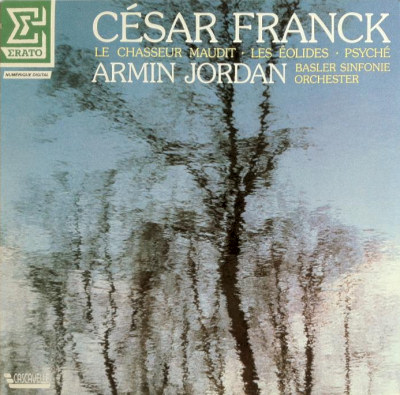
Continuer la lecture de César Franck – Poèmes symphoniques – Symphonic poems – Béatitudes
Pascal Amoyel & Francis Huster- Festival Notes d’automne du Perreux
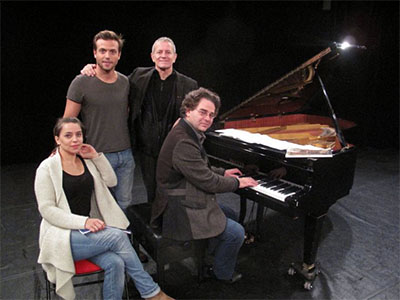
2012 : Pascal Amoyel est donc Directeur artistique du Festival Notes d’automne de la ville du Perreux. Festival original centré sur la musique mais celle-ci étant présentée dans des circonstances variées et mise en scène, afin de « casser un peu le rituel du concert de la musique et essayer de toucher de nouveaux publics ». Les artistes y ont carte blanche.
La soirée d’hier « Manhattan rapsody » était un spectacle autour de l’idée d’une conférence de Chaplin annoncant son premier film parlant qui serait consacré à Georges Gershwin, récemment disparu*. Un spectacle sympathique, bien rythmé, qui avait surtout le mérite de nous faire entendre le pianiste dans Gershwin ; pas notre répertoire préféré mais il est comme toujours épatant !
* comme je le rappelait hier, en fait Charlie Chaplin avait la plus grande admiration pour la pianiste Clara Kaskil et Georges Gershwin avait une seule idole : Arnold Schoenberg, dont il fit d’ailleurs le portrait.
2013 : A noter dans la programmation 2013, le concerto de Grieg avec Pascal Amoyel le jeudi 14 novembre.

J’ai eu la chance d’assister au spectacle « Le pianiste aux 50 doigts » de Pascal Amoyel, au Théâtre du Ranelagh, début 2012. C’est épatant :
« Un des tous meilleurs pianistes français rend hommage à son maître György Cziffra au cours d’un spectacle aussi bien musicalement captivant qu’émouvant.
La première partie de la vie du « pianiste aux 50 doigts » est ainsi scénarisée de façon très habile et permet à Pascal Amoyel, pianiste, chambriste, compositeur, professeur de conservatoire et… comédien, de montrer qu’il est le digne successeur de son maître.
Emmenez-y vos enfants ou petits-enfants ! »
Le spectacle sera repris dans les prochains mois : cf. Site de Pascal Amoyel.
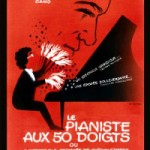
Cycle Schumann – Yannick Nézet-Séguin – Chamber orchestra of Europe – Nicholas Angelich
|
Décidément, après Peraya il y quelques semaines, on vient encore de quitter un concert à l’entracte… On avait été alléché par le programme qui clôturait un cycle symphonique Schumann à la Cité de la musique et par la réputation croissante du chef d’origine québécoise, Yannick Nézet-Séguin, accessoirement par le soliste que l’on n’avait jamais entendu en concert, Nicholas Angelich. A entendre les applaudissements bravos, embrassades, bis après le concerto, j’ai été dû être un des seuls à partir (mais j’ai bien repéré quelques autres mélomanes qui trouvaient le temps long…). L’ouverture Genoveva tout d’abord ; on se dit qu’il faut bien que tout le monde se chauffe un peu. Le dynamisme de la fin après de longues minutes assez plates auraient dû nous mettre la puce à l’oreille. Chef assurément professionnel (il faut l’être pour avoir en même temps des responsabilités permanentes à Londres, Montréal, Philadelphie et Rotterdam), Yannick Nézet-Séguin est un chef à la battue claire et efficace. Justement l’ouverture était très claire… le faible effectif (avec un vibrato très réduit aux cordes) nous prive de « pâte » romantique. Devient-on un vieux barbon aigri, nostalgique des Furtwängler ou Kubelik ? Je ne crois pas : cf. notre récente discographie comparée du Concerto de Schumann où nous avions adoré la version « politiquement incorrecte » d’Argerich / Rabinovitch… Apparaît donc l’imposant pianiste Nicholas Angelich : le piano a l’air d’un coup se rétrécir. C’est la version la plus longuette de ce concerto que je connaisse : le chef essaie bien d’animer un peu, mais le pianiste reste impassible et prend à chaque fois un tempo un peu plus lent, avec à notre goût beaucoup d’affèteries. Seule la cadence du 1er mouvement sauve la mise. Très belle sonorité ceci dit. En bis : Rêverie. On était bien éberlué au triomphe qui suivait, encore plus en voyant faire applaudir certains solistes (vents) dont les interventions nous parurent un peu intempestives et pas toujours de la plus belle sonorité… On a écrit ce petit papier en écoutant le fin du concert sur le Net. La 2e, que le chef dirige cette fois sans partition, dont la qualité essentielle est le dynamisme, me fait penser finalement à la version Paul Paray… Si vous avez lu ce papier jusqu’au bout sachez que vous pouvez vous faire une idée par vous-même sur medici.tv ! Et puisqu’on parle de medici.tv, allez plutôt écouter l’excellent concert de l’Orchestre de Paris dirigé par Paavo Järvi et Rudolf Buchbinder… |
Definitely, after Peraya a few weeks ago, we leave again a concert after the intermission… To hear the applause, cheers, embraces, after the concerto, I was probably the only one to leave (but I located some other music lovers who also found time very long…). The Genoveva overture to begin; one thinks that it is necessary for everyone to” heat” a little. Undoubtedly Yannick Nézet-Séguin is a pro (which is necessary to be able to have at the same time permanent responsibilities in London, Montreal, Philadelphia and Rotterdam), with a clear and effective beating. Precisely the opening was very clear… the orchestra’s small size (with a very reduced vibrato for the strings) deprives to us of romantic “paste”. Does one become a nostalgic greybeard of Furtwängler or Kubelik? I don’t think: cf. our recent compared discography of the Concerto by Schumann where we had adored the “politically incorrect” version of Argerich / Rabinovitch… Then the imposing pianist Nicholas Angelich appears: the piano seems to reduce its size… It was one of the most boring lecture of this concerto I know: the conductor tries well to animate a little, but the pianist remains impassive and takes each time a tempo a little slower, with our taste many affects. Only the cadence of the 1st movement saves the lecture. Yet he has a very beautiful sound. I was well astounded by the triumph which followed, even more while seeing making applaud certain soloists (winds) whose interventions appeared a little inopportune to us and not always of most beautiful sonority… I am writing this small paper listening back home to the end of the concert on the Net. The 2nd symphony, conducted this time without score, has dynamism for essential quality ; it makes me think finally of the Paul Paray version … If you read this paper until the end, you can make your own judgment on medici.tv! And speaking about medici.tv, go and listen to an excellent concert by the Orchestre de Paris conducted by Paavo Järvi with Rudolf Buchbinder… |
Arturo Benedetti Michelangeli – Debussy – Ravel
 Continuer la lecture de Arturo Benedetti Michelangeli – Debussy – Ravel
Continuer la lecture de Arturo Benedetti Michelangeli – Debussy – Ravel
Alfred Cortot – Grand art avec fausses notes – Christian Doumet
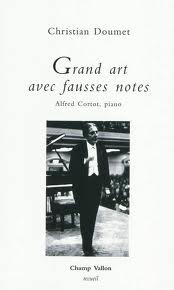
« […] ce parfum de fraîcheur noire qui nous le fait reconnaître dès les premières brises ».
On a acquis un peu par hasard chez un soldeur cet ouvrage, eu égard à notre admiration pour le plus grand pianiste du XX siècle – avec Rachmaninov. Pianiste devenu d’ailleurs plus célèbre pour sa collaboration pendant la guerre et les nombreuses fausses notes et trous de mémoire qui émaillèrent ses concerts de la fin de sa vie que pour son art si singulier.
On avoue avoir d’abord abandonné sa lecture, se disant que la vie est trop courte pour lire des inepties sophistiquées… On l’a pourtant repris… et fini à toute allure. Il est bien difficile d’écrire sur la musique ou sur les interprètes ; on a pourtant ici un suite de « flashes » sur différents aspects du personnage – y compris les plus sombres – qui interpellent le lecteur tant sur ce personnage que sur la musique en général.
C’est parfois un peu abscons, mais le plus souvent pénétrant.
Il apparaît que l’auteur est Professeur d’université, agrégé de lettres, ancien élève de l’ENS et Docteur es-lettres… Il a écrit L’Isle joyeuse. Sept approches de la singularité musicale (1997), je m’en vais revoir mon soldeur…
« Cheval galopant d’inquiétude, fuyant vers un immense horizon de calme ».
On peut écouter certaines de ses interventions à la radio suisse ici.
Rappelons qu’en 1952, le Japon donna le nom de « Cortoshima » à une des îles de l’archipel…
Le piano de Debussy et la musique Russe – Debussy piano works and Russian music
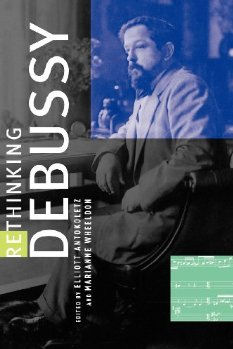
|
« Rethinking Debussy » : un titre un peu ambitieux pour cet ouvrage collectif, néanmoins très intéressant : ses nombreux « Printemps » du début*, Pelléas, ses royalties, l’accueil de ses œuvres… On s’intéressera ici au chapitre consacré à l’influence de la musique russe sur les œuvres pour piano de Debussy. Il faut rappeler tout d’abord l’écho grandissant de la musique russe à Paris dans la dernière partie du 19e siècle et le fait que Debussy passa de nombreux mois chez Nadezhda von Meck, la « chaperonne » de Tchaikovsky. Un premier exemple fourni par Roy Howat (pianiste et musicologue) de l’influence russe sur le jeune Debussy en est la 2e Arabesque (1891) avec le Chant de l’alouette de l’Album pour la jeunesse op. 39 de Piotr. On notera également l’influence de Balakirev (Tamara) sur sa Ballade slave (1899) ou son Nocturne (1892). Les mesures 32-34 de ce dernier peuvent être d’ailleurs mises en parallèle avec les mesures 57-59 du 2e mouvement de la Pathétique de Tchaïkovski. Debussy déclarait en 1893 : « Chabrier, Moussorgski, Palestrina, voilà ce que j’aime ». On peut effectivement déceler une réminiscence des « Cloches du Kremlin » de Boris dans la 3e des Images oubliées, ou dans la Cathédrale engloutie. L’auteur, c’est plus surprenant, retrouve cette tournure moussorgskienne au milieu de l’Hommage à Rameau, mes. 49-47 (1905). De même pour Général Lavine excentric (1913) ; Jumbo’s Lullaby, la Fille aux cheveux de lin ou encore Ce qu’a vu le vent d’Ouest, la Berceuse héroïque (1914), jusqu’au mouvement central de En blanc et en noir (1915). Pour revenir à Balakirev, notons encore la correspondance entre Islamey – mes. 181-183 et l’Isle joyeuse – mes. 186-188. Puisque l’on parle d’Islamey – Ravel voulait faire plus virtuose avec Scarbo et on peut penser que cette pièce inspira aussi à Debussy l’idée de l‘Isle joyeuse -, ci-dessous un extrait d’un concert de la version orchestrale par Svetlanov, justement célèbre par son côté délirant, encore une source de dopamine… 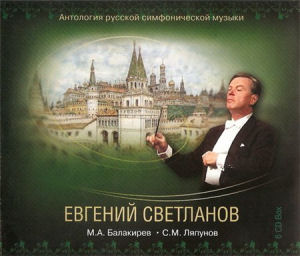 * Cf. Claude Debussy – Musique du prix de Rome – Glossa |
“Rethinking Debussy”: a little ambitious title for this collective work, nevertheless very interesting: his many “Springs” * as a young composer, Pelléas, his royalties, the reception of his works… We illustrate here the chapter devoted to the influence of the Russian music on his piano works. It is necessary first to recall the growing echo of the Russian music in Paris in the last part of the 19th century and the fact that Debussy spent many months with Nadezhda von Meck, the “chaperone” of Tchaikovsky. One will also note the influence of Balakirev (Tamara) on his Slavic Ballade (1899) or his Nocturne (1892). Bars 32-34 of this last can be put besides in parallel with bars 57-59 of the 2nd movement of Pathetic of Tchaïkovski. Debussy declared in 1893: “Chabrier, Moussorgski, Palestrina, here are what I like”. One can indeed detect a reminiscence of the “Bells of the Kremlin” of Boris in 3rd of the Images oubliées, or in the Cathédrale engloutie. The author, more surprisingly, finds this Musorgsky pattern in the middle of the Hommage à Rameau, b. 49-47 (1905). [left] In the same way for General Lavine excentric (1913); Jumbo’s Lullaby, La fille aux cheveux de lin or Ce qu’a dit le vent d’ouest, Berceuse héroïque (1914), until the central movement of En blanc et en noir (1915). To return to Balakirev, still let us note the correspondence between Islamey – b. 181-183 and l’Isle joyeuse – b. 186-188. [left] Speaking about Islamey – Ravel with Scarbo wanted to write an even more virtuoso piece and one can think it inspired also Debussy writing l‘Isle joyeuse -, on the left an extract from a live concert of the orchestral version by Svetlanov, another source of dopamine… * Cf. Claude Debussy – Musique du prix de Rome – Glossa |
|
|
Falla – Nuits dans les jardins d’Espagne – Nights in the Gardens of Spain
|
Falla – Nuits dans les jardins d’Espagne – Nights in the Gardens of Spain |
|
Ne lisez pas tout de suite ce qui suit ! c’est une tentative de réhabiliter une fois de plus un enregistrement mésestimé de Kubelik. Mais ce n’est pas le plus important : l’important est que Pierre Barbier – Pragadigitals -a encore réussi un tour de magie : tout mélomane un peu âgé connaît par cœur cet enregistrement du Tricorne par Ansermet, non seulement par son indépassable interprétation, mais aussi par la « fabuleuse » prise de son Decca de l’époque. Eh bien, il réussit à nous restituer encore mieux cet enregistrement : les timbres sont mieux caractérisés, il y a « de l’air » entre les instruments, et surtout on « sent » le chef d’orchestre diriger, comme pour une bonne prise de concert, comme si on était dans le studio. On entend même pour la première fois une légère fausse note à 2’54 » dans le 2e mouvement du Tricorne… Bref, précipitez-vous ! Il est bien intéressant de pouvoir comparer deux versions des Nuits dans les jardins d’Espagne a priori bien différentes, voire antagonistes : d’un côté une pianiste très célèbre qui fut à ses dires quasiment toujours mécontente de ses enregistrements studio avec orchestre et dont un des chefs d’orchestre préférés était Raphaël Kubelík, de l’autre une pianiste, Margrit Weber, dont on sait peu de choses de nos jours, avec un chef alors vedette du fameux label jaune qui accepta d’enregistrer en studio des œuvres qui n’étaient pas à son répertoire habituel : Concerto de Grieg, Fireworks ou Water music de Haendel, etc. La version Kubelík est-elle si musicienne mais un peu Franckiste comme j’ai pu l’écrire ? 1er mouvement : Chez Kubelík, l’entrée est superbe, le piano moins brillant que l’on attendrait, un peu dans les touches de l’instrument. De l’abattage de la part de la pianiste mais çà ne sonne pas espagnol, plutôt un peu « gras ». Kubelík est là tel un grand maître, on le voit diriger cela… Avec Haskil / Markevitch, c’est plus posé, avec des sonorités plus recherchées, mais c’est moins « organique », l’orchestre est plus extraverti que chez Kubelík, mais il a tendance à couvrir la soliste, qui ne fait d’ailleurs pas forte impression. Bref, si l’orchestre fait (faussement ?) plus couleur locale, mais avec apparemment un accord de l’orchestre un peu plus haut, on est un peu mitigé. Le 2e mouvement : on se dit que c’est tellement espagnol (quel compositeur !) que Kubelík va avoir du mal, surtout vue l’imbrication piano / orchestre de ce mouvement ; le piano est toujours un peu en retrait au point de vue des timbres mais a de l’alacrité, certes les vents n’ont pas tout à fait la couleur idoine, le rythme peut paraître un poil empesé… mais tout est tellement musical. Haskil : c’est un peu plus rapide, encore un peu réglé plus haut, c’est plus criard et extraverti, mais on peut prendre çà comme une qualité ici, le pianisme est plus délié, mais on ne peut s’empêcher de penser que la caractérisation plus importante de la partition se fait au détriment de son unité : beaucoup de -superbes- effets à l’orchestre mais quand la pianiste veut être à l’unisson, çà détimbre un peu. On est encore moins sûr pour le 3e mouvement : c’es toujours apparemment plus vivant chez Markevitch, mais c’est quand même assez brouillon et un peu agressif au niveau de l’orchestre et le piano sonne dur. |
Do not read immediately what follows! It is an attempt to once more rehabilitate a low esteemed recording of Kubelik. But it is not the most important: the important thing is that Pierre Barbier – PragaDigitals – has again made a turn of magic: any rather old music lover knows this recording of the Three cornered hat by Ansermet, not only by his unsurpassed interpretation, but also by the “fabulous” sound recording Decca of 1961. Well, it’s even better in this reissue, restored from original tapes : tones are more characterized, there is “air” between the instruments, and one can feel the conductor’s gestures, as for a good live recording, as if one were in the studio. Just get it! It is quite interesting to be able to compare two versions of the Nights in the gardens of Spain a priori so different, even antagonistic: on a side a very famous pianist who declared being almost always dissatisfied with her studio recordings with orchestra, whom one of her preferred conductors was Raphaël Kubelík, on the other side, a pianist, Margrit Weber, with a conductor who accepted for the famous yellow label to record in studio works which didn’t belong to his usual repertory: Concerto of Grieg, Fireworks or Watermusic by Haendel, aso. 1st movement: With Kubelík, the entry is superb; the piano has less brilliance we could expect. Mastery from the pianist but it does not sound Spanish, rather a little “fatty”. Kubelík is there as usual a superb musician, one sees him directing that… 2nd movement: one thinks that it is so Spanish that Kubelík will not pass, especially with the overlap piano/orchestra of this movement; the piano is a little soft-toned, but has alacrity, certainly the winds do not have the suitable color, the rhythm can appear a little bit heavy… but all is so musical. We are even less sure for the 3rd movement: it is always apparently more alive with Markevitch, but it is nevertheless rather aggressive at the orchestra and the piano sounds hard. In short, more musicianship with Kubelík, but more “local colour” and alive with Markevitch. |